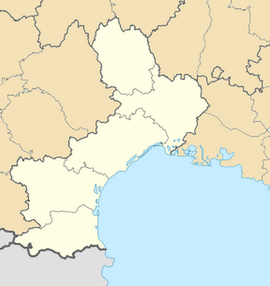Saint-André-de-Lancize
| Saint-André-de-Lancize | |
|---|---|
|
The temple of Rouve Bas: today disused, it is at the heart of a project devoted to the memory of Camisard war in Bougès mountains (Cévennes)[1] | |
 Saint-André-de-Lancize | |
|
Location within Languedoc-Roussillon region  Saint-André-de-Lancize | |
| Coordinates: 44°15′32″N 3°48′40″E / 44.2589°N 3.8111°ECoordinates: 44°15′32″N 3°48′40″E / 44.2589°N 3.8111°E | |
| Country | France |
| Region | Languedoc-Roussillon |
| Department | Lozère |
| Arrondissement | Florac |
| Canton | Saint-Germain-de-Calberte |
| Intercommunality | Vallée Longue et du Calbertois en Cévennes |
| Government | |
| • Mayor (2008–2014) | Violaine Martin |
| Area1 | 22.78 km2 (8.80 sq mi) |
| Population (1999)2 | 112 |
| • Density | 4.9/km2 (13/sq mi) |
| INSEE/Postal code | 48136 / 48240 |
| Elevation |
376–1,351 m (1,234–4,432 ft) (avg. 700 m or 2,300 ft) |
|
1 French Land Register data, which excludes lakes, ponds, glaciers > 1 km² (0.386 sq mi or 247 acres) and river estuaries. 2 Population without double counting: residents of multiple communes (e.g., students and military personnel) only counted once. | |
Saint-André-de-Lancize is a commune in the Lozère department in southern France.
History
History of the commune is mainly marked by the Camisards revolt, which started on July 22, 1702, in Vieljouves, a hamlet located above the village of Le Rouve.[2][3] On the same evening, upon invitation by Salomon and David Couderc, two brothers living in Le Rouve, a group gathered around the woolcomber Abraham Mazel, a "prophet", who received a "divine" inspiration[4] giving him the instruction to deliver huguenots made prisoners and tortured by François Langlade, the abbé of Chayla at Pont-de-Montvert. The following Sunday was devoted to mobilize people who were volunteers to release prisoners. On July 24, fifty men, armed with some guns, axes and scythes, gathered on top of Bougès mountain, at a site named "Les treis Faus" or "Les trois fayards" (meaning "Three beeches" in Occitan and French language, respectively). On the same evening, around 10 AM, they entered Pont-de-Montvert while singing a psalm. They asked, as their only claim, to liberate prisoners. Upon refuse, they liberated them by force, in the course of a violent fight where François Langlade died.[5] So went the Camisards war, also called war of the Cévennes, which later on extended to the whole Cévennes area, and lasted two years.[6]
See also
References
- ↑ "Le Temple du Rouve (English)". Retrieved 1 February 2015.
- ↑ Pierre-Jean Ruff, 2008. Le Temple du Rouve: lieu de mémoire des Camisards. Editions Lacour-Ollé, Nîmes (in French).
- ↑ Henry Mouysset, 2010. Les premiers Camisards: juillet 1702. Nouvelles Presses du Languedoc, Sète (in French).
- ↑ Abraham Mazel, Élie Marion, Jacques Bonbonnoux, 1983. Mémoires sur la guerre des Camisards. Les Presses du Languedoc, Montpellier (in French).
- ↑ Robert Poujol, 1986. Bourreau ou martyr? L'abbé du Chaila (1648-1702): du Siam aux Cévennes. Nouvelles Presses du Languedoc, Sète (in French).
- ↑ Antoine Court de Gébelin, 2009. Histoire des troubles des Cévennes ou de la guerre des camisards sous le règne de Louis le Grand, réédition de l'oeuvre originale imprimée en 1760. Editions Lacour-Ollé, Nîmes (in French).
| Wikimedia Commons has media related to Saint-André-de-Lancize. |
